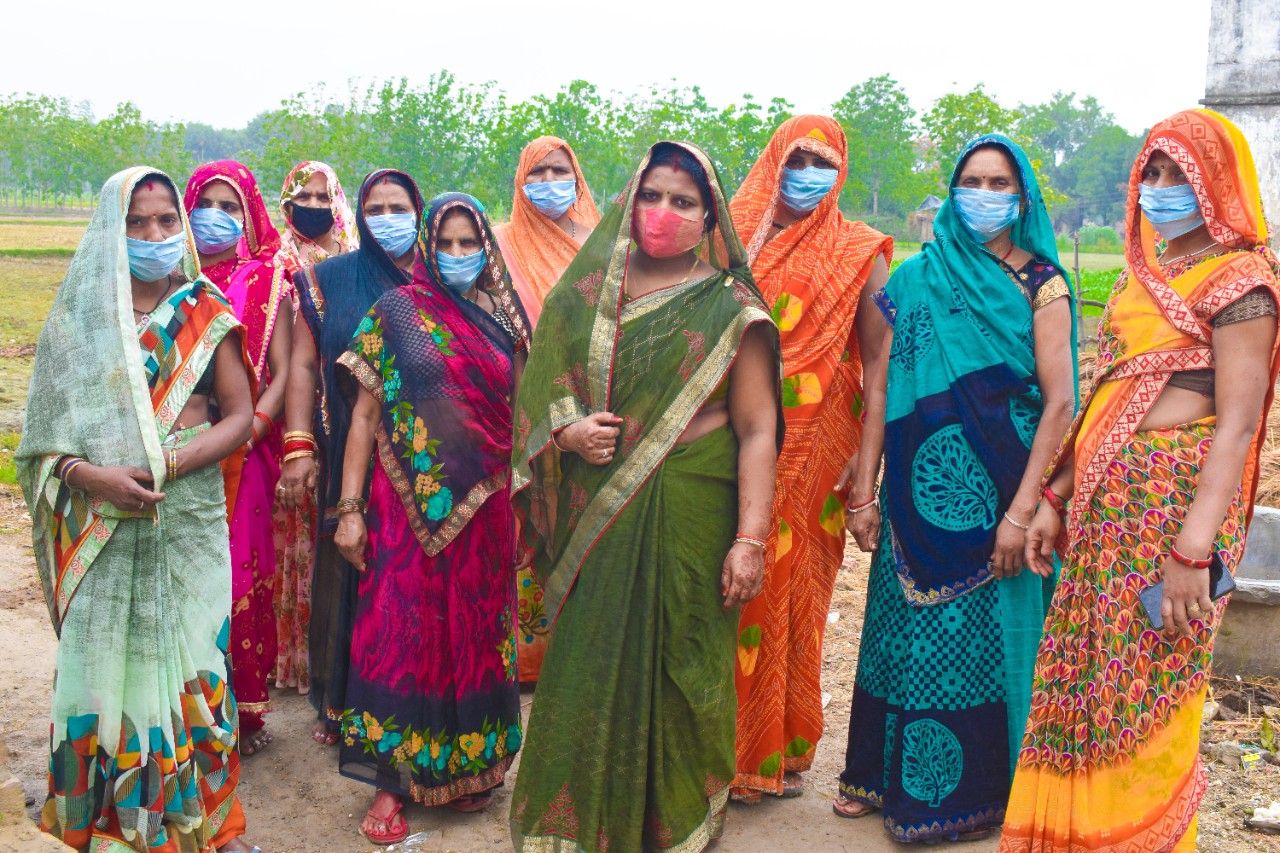In rural Uttar Pradesh, India women are leading agri supply chain models thereby enhancing incomes & breaking stereotypes.
Women lead the way: from farm to market
August 1, 2022

The women-led Farmer Producer Group at Krishnaduttpur village.
There is a revolution of sorts brewing in small villages of the largest state in India. Though COVID-19 pandemic depleted savings and lowered farm income, women in the hinterlands of Uttar Pradesh took it upon themselves to fight inequities in farm produce sales, side-stepping the middleman to sell directly to processing mills.
Sindhu Singh of Deepapur village, near Varanasi, also known as the spiritual capital of India, has been using her persuasion skills to convince a group of farmers to sell nearly 88 tons of Katarni paddy (a type of fragrant rice) to a procurement centre she manages.
“Covid 19 has not only affected people's health but also hit the earnings of small-time farmers terribly. For small farming households like mine, it made everything more difficult – from sowing, harvesting to selling our produce” recollects Sindhu.
Women like Sindhu Singh are working as a collective to get better prices for farm produce.
While increase in agriculture production was the silver lining in the Indian economy during the first year of the COVID-19 pandemic, the second wave ravaged this sector as well. As the pandemic entered rural India, consequent lockdowns affected the agriculture supply chain and left farmers, especially smaller landowners, in the lurch.
Uttar Pradesh State Rural Livelihoods Mission (UPSRLM) in partnership with the United Nations Development Programme (UNDP), embarked in July 2020 on a project to organise women from farming families into a collective and equip them with skills to develop a farm to market efficient supply chain. This intervention, which lasted till March 2021, was part of a larger COVID-19 socio-economic recovery initiative and aimed to bring women to the forefront of the agri-business industry.
Women like Sindhu now work at a women-led procurement centre managed by a farmer producer group called the Sheetala Mata Prerna Producer Group. There are several such groups operating in twelve blocks of six districts in eastern Uttar Pradesh.
Prior to joining her village's FPG, Chandravati Devi was taking care of cows at her home.
Traditionally, women were entrusted with work such as weeding, sowing, transplanting and harvesting in agriculture. Selling the produce was the domain of the male member of the household. They were also involved in taking care of ancillary activities like animal husbandry. This is now changing.
This programme, conducted in co-ordination with Arya Collateral Warehousing Services, builds managerial capacities of rural women by educating them on agri-business models, and creates new job roles, such as women sourcing managers and women business managers.
The participants underwent a 10-day training session for women sourcing managers. They were trained in mobilisation of farmers for aggregation, quality testing, price discovery, logistics, and coordination with buyers. These training modules were especially developed for accelerated learning by rural women with a basic level of school education.
The women now handle all activities related to procurement and inventory management such as grading, sorting, weighing, storing, loading, unloading, invoicing and co-ordinating logistics to send the produce to processing mills.
“Earlier, the middlemen used to pay not more than INR 12-13/kg of paddy to the farmers, but ever since we started offering INR 14.50/kg to the farmers, the middlemen have also increased their offer. This has greatly helped paddy farmers in the region. We have already dispatched a truck with 25 MT paddy and are now in the process of sending the next one, while more quantities are in pipeline,” says Sindhu.
As part of the UNDP-UPSRLM partnership, over 200 new job roles for women sourcing managers were created in six districts of Uttar Pradesh (Varanasi, Chandauli, Mirzapur, Sonbhadra, Gorakhpur, Deoria). This supported 120 producer groups and two women-owned farmer-producer companies, which, in turn were linked to 4,000 small and marginal women farmers. Procurement centres were created in the villages themselves, which enabled women sourcing managers to understand the market requirements.
Despite modest beginnings, women producer groups in these districts have been able to sell 93 metric tonnes of Katarni Paddy to buyers between December 2020 and January 2021. This enabled them to earn at least 20% more than prevailing market price for this variety of paddy. To overcome procedural hiccups and establish trust with the community, farmers were paid in advance for their produce, which went a long way in building community relationships. The process was enabled by a2zgodaam, an agri-tech platform.
Farmer Producer Group members tallying the procurement figures at Dhanapur village.
“I think it is only fair that farmers get maximum share of profit on their agriculture produce. I, along with the women in my village, are working towards that,” said Reena Singh of Chariyao Khas village, Deoria who is often seen mobilizing women from other households and is now in the process of helping farmers setup a Farmer Producer Organization.
This initiative demonstrates that with the right skills training, women can perform functions that are traditionally assigned to men. Even within highly patriarchal societies, there can be cultural acceptance of women in non-traditional roles, if the male members of the house are engaged through dialogue right from the start.
These women-led agri supply chain models have the potential to impact more than 118.7 million farmers in India (number of farmers as per Census 2011). Facilitating the transition of women from production into market-oriented roles can help to achieve several of the UN Sustainable Development Goals 2030 not limited to gender equality.
The pandemic has significantly slowed down India’s economic growth. While we are now on a path to gradual economic recovery, placing women at the centre-stage of agri-business, can help make this recovery faster, fairer and more inclusive.

 Locations
Locations